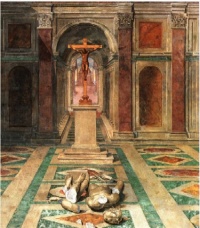Cult (religious practice)
From The Art and Popular Culture Encyclopedia

Illustration: Triumph of Christianity (detail) by Tommaso Laureti (1530-1602.)
|
Related e |
|
Featured: |
In traditional usage, the cult of a religion, quite apart from its sacred writings ("scriptures"), its theology or myths, or the personal faith of its believers, is the totality of external religious practice and observance, the neglect of which is the definition of impiety. Cult in this primary sense is literally the "care" (Latin cultus) owed to the god and the shrine. In the specific context of Greek hero cult, Carla Antonaccio has written, "The term cult identifies a pattern of ritual behavior in connection with specific objects, within a framework of spatial and temporal coordinates. Ritual behavior would include (but not necessarilly be limited to) prayer, sacrifice, votive offerings, competitions, processions and construction of monuments. Some degree of recurrence in place and repetition over time of ritual action is necessary for cult to be enacted, to be practiced"
Cult is embodied in ritual and ceremony. Its present or former presence is made concrete in temples, shrines and churches, and cult images (denigrated by Christians as "idols") and votive deposits at votive sites.
By extension, "cult" has come to connote the total cultural aspects of a religion, as they are distinguished from others through change and individualization.
The comparative study of cult practice is part of the disciplines of the anthropology of religion and the sociology of religion, two aspects of comparative religion. In the context of many religious organisations themselves, the study of cultic or liturgical practises is called liturgiology.
Contents |
Etymology
The term "cult" first appeared in English in 1617, derived from the French culte, meaning "worship" or "a particular form of worship" which in turn originated from the Latin word cultus meaning "care, cultivation, worship," originally "tended, cultivated," as in the past participle of colere "to till the soil". In French, for example, sections in newspapers giving the schedule of worship at Catholic churches are headed Culte Catholique; the section giving the schedule of Protestant churches is headed culte réformé.
The meaning "devotion to a person or thing" is from 1829. Starting about 1920, "cult" acquired an additional six or more connotatively positive and negative definitions that are separately discussed in the article Cult.
Roman Catholic cultus
In Roman Catholicism, cultus or cult is the technical term for devotions or veneration extended to a particular saint.
The Christian Church makes distinctions between worship and veneration, both of which can be outwardly expressed in a similar manner. Catholicism and Eastern Orthodoxy distinguish between worship (Latin adoratio, Greek latreia [λατρεια]) which is only acceptable to be offered to God alone, and veneration (Latin veneratio, Greek doulia [δουλεια]), which may be offered to the saints. These distinctions between deity and mediators are exhaustively treated at the entries for latria and dulia.
Cult practice
Among the observances in the cult are rituals, ceremonies, liturgy or audits, which may involve spoken or sung words, and often involve personal sacrifice. Other manifestations of the cult of a deity are the preservation of relics or the creation of images, such as icons (usually connoting a flat painted image) or three-dimensional cultic images, denigrated as "idols", and the specification of sacred places, hilltops and mountains, fissures and caves, springs, pools and groves, or even individual trees or stones, which may be the seat of an oracle or the venerated site of a vision, apparition, miracle or other occurrence commemorated or recreated in cult practices. Sacred places may be identified and elaborated by construction of shrines and temples, on which are centered public attention at religious festivals and which may become the center for pilgrimages.
Cult centers
Many cities in the Ancient Near East were home to the cult centers of certain deities, such as Marduk in Babylon or Ptah in Memphis.
See also
- Cult of Reason
- Cult following
- Cult image
- Cult of personality
- Hero cult
- Imperial cult
- Impiety
- Religion

